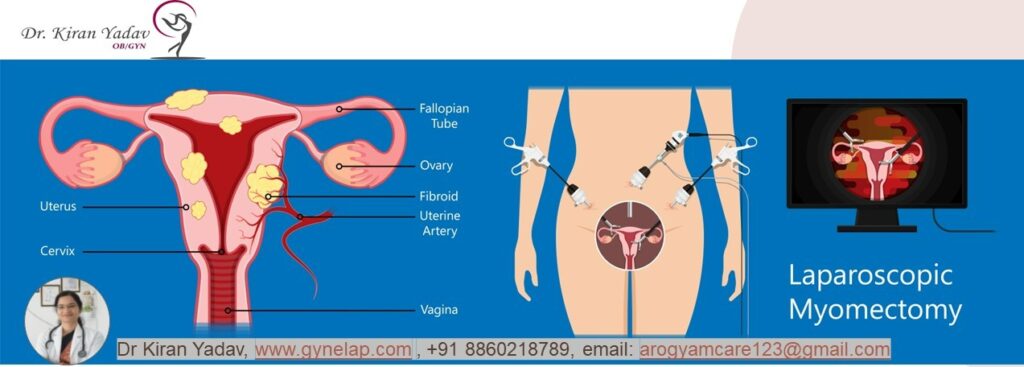Myomectomy: Surgical Treatment for Uterine Fibroids
Uterine myomectomy is a surgical procedure that removes uterine fibroids. Fibroids also called as leiomyomas, are non-cancerous growths of tissue that develop in the uterus. Uterine fibroids can cause symptoms such as heavy menstrual bleeding, pelvic pain, pressure, frequent urination, and infertility.
Uterine myomectomy preserves the uterus and the ability to become pregnant in the future. It is an option for women who want to keep their uterus for personal or reproductive reasons, or who have fibroids that interfere with their fertility or quality of life.
Types of Uterine Myomectomy:
- Abdominal myomectomy: This type of surgery involves making an incision in the lower abdomen and removing the fibroids through the opening. Done for very large or multiple or deep fibroids.
- Laparoscopic myomectomy: small keyhole incisions made in the abdomen and instruments (laparoscope) inserted through them to remove the fibroids. It may also be done robotically, with the surgeon controlling the instruments from a console. Laparoscopy is less invasive with shorter recovery time.
- Hysteroscopic myomectomy: a thin tube with a camera and instruments (hysteroscope) inserted through the vagina and cervix and into the uterus to remove the fibroids. No incisions or anesthesia. Suitable for small fibroids inside the uterine cavity.
To Book Appointment for Myomectomy
A myomectomy is a surgical procedure aimed at removing uterine fibroids—noncancerous growths in the uterus. Unlike a hysterectomy, which removes the entire uterus, a myomectomy focuses on removing only the fibroids while preserving the uterus. This makes it an ideal option for women who want to maintain their fertility or keep their uterus for other personal or health reasons.
1. What is Myomectomy?
Myomectomy is a surgical procedure designed to remove fibroids from the uterus. Fibroids, also known as leiomyomas or myomas, are benign tumors that develop in or on the uterine walls. These growths can vary in size and number and are a common condition in women of reproductive age. A myomectomy is performed to relieve symptoms caused by fibroids, such as heavy menstrual bleeding, pelvic pain, and pressure on the bladder or bowel.
2. Types of Myomectomy Procedures
There are several approaches to performing a myomectomy, depending on the size, number, and location of the fibroids. The three primary types of myomectomy are:
Abdominal Myomectomy (Open Myomectomy): This is a traditional surgical procedure in which an incision is made in the lower abdomen to access the uterus and remove the fibroids. It is typically used for larger or multiple fibroids that are deeply embedded in the uterine wall. Recovery time is longer with this method, but it is effective for more complex cases.
Laparoscopic Myomectomy: A minimally invasive procedure where small incisions are made in the abdomen, and a laparoscope (a thin, lighted tube with a camera) is used to guide the surgeon in removing the fibroids. Laparoscopic myomectomy is less invasive, with a quicker recovery time and smaller scars. This method is suitable for smaller fibroids or fewer in number.
Hysteroscopic Myomectomy: In this procedure, the fibroids are removed through the vagina using a hysteroscope (a thin, lighted tube inserted through the cervix). This technique is ideal for fibroids located inside the uterine cavity (submucosal fibroids). It is also a minimally invasive approach and usually requires little downtime.
3. Who Needs a Myomectomy?
A myomectomy is recommended for women who experience symptoms caused by fibroids, particularly when the fibroids interfere with daily life or reproductive health. Common symptoms that may lead to a myomectomy include:
- Heavy Menstrual Bleeding: Fibroids can cause excessive menstrual bleeding, leading to anemia or fatigue.
- Pelvic Pain and Pressure: Large fibroids can cause pressure or pain in the lower abdomen, pelvis, or back.
- Frequent Urination or Constipation: Fibroids pressing on the bladder or bowel can result in frequent urination or constipation.
- Infertility or Pregnancy Complications: Fibroids can affect fertility by blocking the fallopian tubes or distorting the uterine cavity, making it difficult to conceive or carry a pregnancy to term.
- Desire to Preserve Uterus: Women who want to maintain their fertility or avoid a hysterectomy may opt for a myomectomy.
4. Benefits of Myomectomy
The primary benefit of a myomectomy is the removal of fibroids while preserving the uterus. This makes it an excellent option for women who:
- Want to Have Children: Myomectomy offers women the chance to maintain their fertility and conceive in the future.
- Avoid Hysterectomy: For women who wish to keep their uterus for personal or health reasons, a myomectomy provides an alternative to hysterectomy.
- Relief from Symptoms: Myomectomy effectively alleviates the symptoms caused by fibroids, such as heavy bleeding, pelvic pain, and pressure.
5. Risks and Complications
While a myomectomy is generally a safe procedure, like any surgery, it comes with potential risks and complications. These may include:
- Bleeding: There is a risk of significant blood loss during surgery, especially with large or numerous fibroids.
- Infection: As with any surgical procedure, there is a risk of infection at the incision site or within the pelvic area.
- Scar Tissue (Adhesions): Surgery can lead to the formation of scar tissue in the uterus or surrounding organs, which may cause pain or complications in future pregnancies.
- Recurrence of Fibroids: Fibroids can recur after a myomectomy, particularly in women who are not yet menopausal. Recurrence may require additional treatment.
- Fertility Issues: Although myomectomy preserves the uterus, it may not guarantee successful pregnancy. The location of the fibroids and the type of surgery performed can impact future fertility.
6. Recovery After Myomectomy
Recovery time varies depending on the type of myomectomy performed:
- Abdominal Myomectomy: Recovery may take 4 to 6 weeks, during which time the patient should avoid heavy lifting, strenuous activities, and sexual intercourse to allow for proper healing.
- Laparoscopic Myomectomy: Recovery is quicker, typically 2 to 4 weeks, as the surgery is less invasive and involves smaller incisions.
- Hysteroscopic Myomectomy: Recovery is usually the shortest, with most women returning to normal activities within a few days to a week.
During recovery, patients are advised to follow their surgeon’s instructions regarding wound care, pain management, and activity restrictions.
7. Myomectomy and Fertility
For women who want to preserve their fertility, a myomectomy can significantly improve their chances of becoming pregnant. By removing fibroids that may be obstructing the fallopian tubes or distorting the uterine cavity, the procedure can create a more favorable environment for conception and pregnancy. However, the success of a myomectomy in restoring fertility depends on factors such as the size, number, and location of the fibroids, as well as the patient’s overall reproductive health.
In some cases, women may be advised to wait several months after the surgery before attempting to conceive, allowing the uterus to fully heal.
8. Alternatives to Myomectomy
Depending on the size, location, and symptoms caused by fibroids, other treatment options may be considered as alternatives to myomectomy:
- Uterine Fibroid Embolization (UFE): A non-surgical procedure that involves cutting off the blood supply to the fibroids, causing them to shrink. UFE is an effective option for women who do not wish to undergo surgery, but it is not recommended for those seeking to preserve fertility.
- Medications: Hormonal medications, such as gonadotropin-releasing hormone (GnRH) agonists, can shrink fibroids temporarily and relieve symptoms. However, they are not a permanent solution, and fibroids typically return once the medication is stopped.
- MRI-Guided Focused Ultrasound (FUS): A non-invasive procedure that uses high-intensity ultrasound waves to destroy fibroids without surgery. This method is relatively new and may not be available everywhere.
- Hysterectomy: For women who do not wish to preserve their uterus or are experiencing severe symptoms, a hysterectomy (removal of the uterus) is a definitive solution for fibroids.
Conclusion
A myomectomy offers women a way to remove troublesome fibroids while maintaining the uterus and preserving fertility. It is an effective treatment option for those seeking relief from the symptoms of fibroids, such as heavy bleeding, pelvic pain, and pressure. While there are risks associated with the procedure, many women experience significant improvement in their quality of life following surgery. Consultation with a healthcare provider is essential to determine the best course of treatment based on individual circumstances and reproductive goals.



